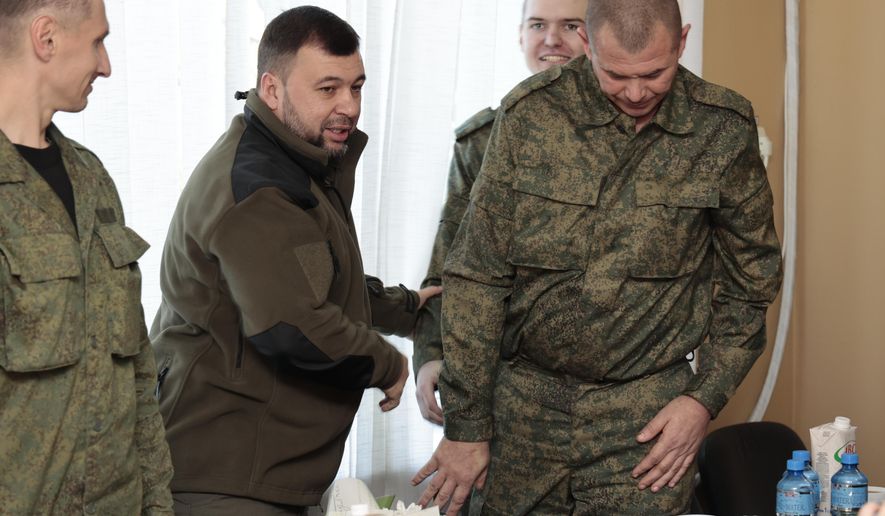KYIV, Ukraine (AP) — Experts from the United Nations’ nuclear power agency on Tuesday were inspecting two sites where Russia has made unfounded claims that Ukraine is manufacturing “dirty bombs.”
International Atomic Energy Agency Chief Rafael Grossi said in a statement that inspections had begun at two locations in Ukraine and would soon be completed. The inspections had been requested by Kyiv in the wake of the Russian allegations.
Top Russian officials including President Vladimir Putin have made unsubstantiated accusations that Ukraine is preparing to use a so-called dirty bomb, an explosive laced with radioactive materials.
Russia’s U.N. ambassador Vassily Nebenzia alleged in a letter to Security Council members last week that Ukraine’s nuclear research facility and mining company “received direct orders from (President Volodymyr) Zelenskyy’s regime to develop such a dirty bomb.”
Western nations have rejected the unsubstantiated claim out of hand, calling it “transparently false.” Ukrainian authorities dismissed it as an attempt to distract attention from Moscow’s own alleged plans to detonate a dirty bomb in order to justify its own escalation of hostilities.
The IAEA has said that both sites being investigated “are under IAEA safeguards and have been visited regularly by IAEA inspectors” whose mission is to detect undeclared nuclear activities, as well as materials related to the development of dirty bombs.
“The IAEA inspected one of the two locations a month ago and no undeclared nuclear activities or materials were found there,” the agency said in a statement Monday.
In a separate development, one person was killed and several buildings were destroyed after four Russian missiles hit the southern city of Mykolaiv around midnight, Mykolaiv Gov. Vitali Kim said on Telegram.
Elsewhere, explosions rocked the city of Poltava in northeastern Ukraine early Tuesday, Poltava Gov. Dmytro Lunin said on Telegram. Four Russian drones crashed into civilian structures in the city igniting a fire, Lunin said. Another three drones were shot down. No casualties were reported.
Overnight Russian shelling struck Ukraine’s southeastern city of Nikopol and nearby Marhanets, Dnipropetrovsk Gov. Valentyn Reznichenko said. Some 40 shells hit Nikopol, which is located across the Dniper River from the Zaporizhzhia nuclear power plant, damaging 14 residential buildings, a kindergarten, a pharmacy, a bank and several shops, the official said.
In Marhanets, damage to a power line and loss of power to a water pumping station temporarily left some 40,000 families without running water and 10,000 families without electricity, according to Reznichenko. Power and water were restored by morning.
Ukraine was still grappling Tuesday with the consequences of Mondays’ massive barrage of Russian strikes which disrupted power and water supplies in multiple Ukrainian cities and villages.
Kyiv Mayor Vitali Klitschko said authorities have restored electricity and running water in Kyiv’s residential buildings, but that rolling power outages would continue in the Ukrainian capital because of significant power shortages.
In Kharkiv, Ukraine’s second-largest city, subway service was suspended again on Tuesday, according to the subway’s Telegram page. No reason for the suspension was given.
In the occupied Kherson region, Russian-installed authorities sought to evacuate up to 70,000 more people living within 15 kilometers (9 miles) of the Dnieper River in anticipation of a Ukrainian counteroffensive pushing deeper into the region. The effort was already underway on Tuesday morning, according to the Kremlin-appointed governor of the region Vladimir Saldo.
In Russia, the regular fall draft got underway Tuesday with a total of 120,000 men expected to be conscripted within the next two months. Russian military officials have assured that conscripts will not be sent to fight in Ukraine, including to the annexed regions.
But the U.S.-based Institute for the Study of War said in its most recent report that the Russian Defense Ministry “is attempting to deceive the Russian population” into believing that autumn conscripts will not be sent to fight in Ukraine, likely to prevent draft dodging.
Russia’s illegal annexation of four occupied Ukrainian regions “means that all of the fighting is taking place in areas that the Kremlin claims as Russian territory,” the report said, so “conscripts will almost certainly be deployed to Ukraine after their training is complete around March or April 2023, and could be deployed sooner in response to changes on the battlefield.”
This year’s fall draft was scheduled to start in October, but was delayed by one month because of the partial mobilization of 300,000 men, which was declared completed on Monday. Kremlin critics have warned that the call-up could resume after the fall draft is over and military enlistment offices are freed up from processing conscripts.




Please read our comment policy before commenting.